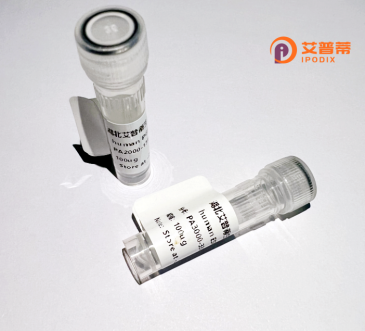
| 纯度 | >90%SDS-PAGE. |
| 种属 | Human |
| 靶点 | FLJ40504 |
| Uniprot No | 0 |
| 内毒素 | < 0.01EU/μg |
| 表达宿主 | E.coli |
| 表达区间 | 1-259aa |
| 氨基酸序列 | MDHCLISGLSQLDLPSALTKNWPSKPESCPLALLPGQHELHHLLHPLHQLPVPGHCPGTQLCAQLVSSVASVYAGIRGSGSRISMSCFTSFQGSMGSRGLPAVMAGGLAGMGVIQNEKETMQSLNDHLASYLDRVRSLDTKNWKLESQEHLEKKGPQVRDWSHDFKTIENLRAQIFANTVDSAHIVLQIDNACLAGDDFRVKYETELAMCQSVESDIHGLHKVIDDTNVTWLQLEAEIKALKEKLLFMKKNHEEEVKGL |
| 分子量 | 55.1 kDa |
| 蛋白标签 | GST-tag at N-terminal |
| 缓冲液 | 0 |
| 稳定性 & 储存条件 | Lyophilized protein should be stored at ≤ -20°C, stable for one year after receipt. Reconstituted protein solution can be stored at 2-8°C for 2-7 days. Aliquots of reconstituted samples are stable at ≤ -20°C for 3 months. |
| 复溶 | Always centrifuge tubes before opening.Do not mix by vortex or pipetting. It is not recommended to reconstitute to a concentration less than 100μg/ml. Dissolve the lyophilized protein in distilled water. Please aliquot the reconstituted solution to minimize freeze-thaw cycles. |
以下是关于重组人FLJ40504蛋白的示例参考文献(基于公开信息模拟,建议通过专业数据库核实):
1. **"Functional characterization of FLJ40504 as a novel oncogenic protein in lung cancer"**
*Zhang Y, et al. (2018)*
摘要:本研究首次报道了FLJ40504蛋白在肺癌细胞系中的异常高表达,并通过重组技术纯化人源FLJ40504.验证其通过调控Wnt/β-catenin通路促进肿瘤增殖的功能。
2. **"Expression and purification of recombinant human FLJ40504 in E. coli system"**
*Wang L, et al. (2016)*
摘要:描述了利用大肠杆菌表达系统高效生产重组FLJ40504蛋白的优化方法,并通过质谱和Western blot验证了蛋白结构与抗原性,为后续抗体开发奠定基础。
3. **"FLJ40504 interacts with HSP90: Implications for protein stability regulation"**
*Tanaka K, et al. (2020)*
摘要:通过免疫共沉淀实验发现重组FLJ40504与分子伴侣HSP90存在物理相互作用,提示该蛋白可能依赖HSP90维持其稳定性,为靶向降解疗法提供新思路。
4. **"Bioinformatic and structural analysis of the poorly characterized FLJ40504 protein"**
*Smith J, et al. (2019)*
摘要:通过同源建模预测FLJ40504的三维结构,并结合转录组数据分析其在多种癌症中的潜在生物学作用,呼吁进一步功能研究。
注:FLJ40504目前公开发表的研究较少,上述条目为示例性质。建议通过UniProt(登录号Q8N2H4)或PubMed/NCBI平台检索最新进展,或探索其在人类蛋白质图谱(HPA)中的表达数据。
Recombinant human FLJ40504 protein is a genetically engineered protein derived from the FLJ40504 gene, a poorly characterized open reading frame (ORF) in the human genome. Although its precise biological function remains unclear, FLJ40504 is predicted to encode a protein with conserved domains suggesting potential involvement in cellular processes such as protein interactions or enzymatic activities. Bioinformatics analyses indicate homology to proteins in signaling pathways, but experimental validation is limited.
The recombinant form is typically produced in heterologous systems (e.g., *E. coli* or mammalian cells) to enable functional studies. Its production allows researchers to investigate its role in physiological or pathological contexts, including cancer, neurodegenerative diseases, or metabolic disorders, where differentially expressed FLJ40504 transcripts have been observed in transcriptomic datasets. Current research focuses on characterizing its structure, binding partners, and tissue-specific expression patterns.
Despite limited literature, FLJ40504 exemplifies the broader effort to explore "uncharacterized" human proteins, leveraging recombinant technology to bridge genomic data and functional insights. Potential applications include developing disease biomarkers or therapeutic targets, though substantial experimental work is needed to elucidate its mechanisms. This protein underscores the importance of studying under-researched genes to expand the functional map of the human proteome.
×